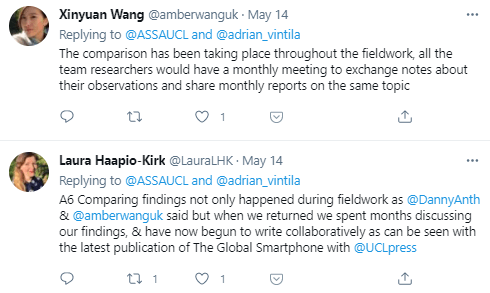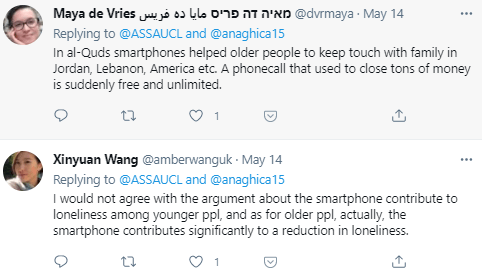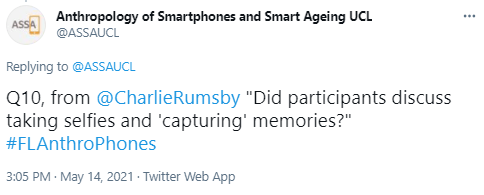ASSA Live Twitter Chat: Questions and Answers
By Georgiana Murariu, on 20 May 2021
Last Friday, the 14th of May, part of the ASSA team (Danny, Laura, Maya, and Xinyuan) took part in a one-hour live chat on Twitter answering questions from members of the public. Since we got quite a few interesting questions and the Twitter thread got quite long, we wanted to publish them here for others to read as well – the post is quite long so be prepared to do quite a bit of scrolling!
Social gerontologist Gemma Carney asked us three questions, which we tackled separately. The first was about gendered preferences when it comes to spending time on the smartphone.

Laura Haapio-Kirk had observed some gender-related dynamic when it came to smartphone behaviour in her fieldsite of Japan:

In his fieldsite of Ireland, Danny Miller notes that gender roles are currently changing but in a traditional household, it is possible that different halves of couples are responsible for different functions/tasks on the smartphone.

Q2, from Yearri Panji Setianto, focused on privacy as a concept that is interpreted differently by different cultures and communities around the world. How did the team develop rapport with participants whilst maintaining it?

Laura Haapio-Kirk responds by emphasising the importance of befriending people:

It is also worth remembering that each researcher spent more than a year in their field site, which helped build trust within the local community, as Xinyuan Wang points out.

In al-Quds, where Maya de Vries and Laila Abed Rabho did their fieldwork, frequently visiting people’s houses and having meals together was a significant part of building and maintaining rapport.

Q3, which came from Cristina (@crixy_5), asked why the ASSA team thought older people did not make use of specialist health apps much.

The answers to this ranged from a lack of digital skills to preferences for already-ubiquitous apps such as WhatsApp as opposed to having to download a specific health-related app. In China, apps with many functions such as WeChat are commonly used for health purposes but older people may also benefit from younger relatives using specialist health apps on their behalf in addition to this.





Q4, from @alwanbrilian, is about using ethnography as a method in the smartphone era.

Ethnography is seen by the ASSA team as a holistic tool that can help place people’s behaviours, preferences, and communication in relation to the rest of their lives:



Q5, from @omru651: ‘What are your most contradictory findings or most surprising ones?’

Each researcher had a different surprising/contradictory finding relating to their fieldsite:




Q6 was a question about our comparative methodology, from @Adrian_vintila:
There were many strands to the comparative methodology: monthly 5000-word reports written by each team member on what was happening in their fieldsite, long hours of analytical discussion, and more!


Q7, from Ana Ghica: “Lots of media articles talk about smartphones and their contribution to an increase in loneliness for teens/younger people. Was this observed in older people in your fieldsites?”
ASSA research did not find any evidence of greater loneliness resulting from smartphone use – on the contrary:

Q8 and Q9 saw us return to the questions social gerontologist Gemma Carney had asked – are children really ‘damaged’ by tech, and is age less important than we think?

Although our project looked at intergenerational relations and the smartphone’s impact on the family, ASSA did not specifically research smartphone use among children. Danny Miller and Xinyuan Wang suggest two great resources for those who do want to read about the issue further – Professor of Social Psychology Sonia Livingstone‘s blog Parenting for a digital future and danah boyd’s ‘It’s Complicated: The Social Lives of Networked Teens’.

Our final question was a great one, sent to us by anthropologist Charlie Rumsby:

Laura had found that while in her fieldsite, older people do take selfies, these are not something they would generally post or even an everyday practice, while Maya found that among her participants, selfies were challenging to take, though more generally, photos were captured all the time.

Danny suggests that smartphone photography is more about sharing images with others rather than capturing memories, and Xinyuan adds that selfies are also a way of crafting the ideal self and social relations. A more detailed discussion of this can be found in chapter 5 of the Global Smartphone book, on pages 110-115.

And with those answers, we wrapped up the live Twitter chat – it was great to be able to have a dialogue with others about our research and findings and we look forward to doing similar initiatives in the future!
In the meantime, we hope that we will be able to continue this dialogue with members of the public at our virtual launch event on the 26th of May, which will take place on Zoom. You can register to attend via Eventbrite and you will get a Zoom link closer to the event. All welcome – we look forward to seeing you there!
 Close
Close





